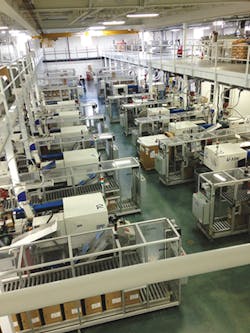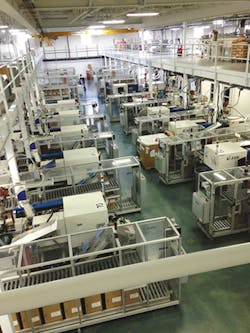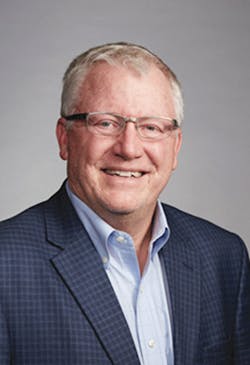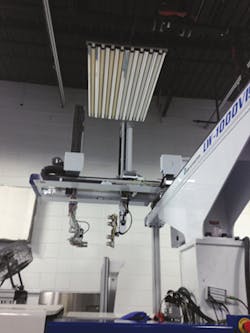Equipment, plant layout allow PCI's lights-out Wisconsin facility to shine
There is an injection molding factory with a patent that isn't just on the machinery running in the facility or a molding process used within its walls. The entire factory has a patent that was awarded in 2014 to Tom Duffey and Ryan Duffey, the father-son team that orchestrated a lights-out injection molding approach in Germantown, Wis., near Milwaukee.
The process patent was granted based on the unique layout of the facility, the combination of equipment and the facility's construction, which includes a mezzanine that houses materials handling and provides a walking platform.
"It's not about an individual piece of equipment," Tom Duffey said of the patent. "It's about how all the pieces of the puzzle were put together out there."
"Out there" is within the second facility for Plastic Components Inc. (PCI), the custom injection molder owned by Tom Duffey. This site operates around the clock as Toyo all-electric injection presses equipped with the latest automation systems make parts.
One person checks in on the facility once a day. That is the extent of human involvement. The machines are fed by a state-of-the-art materials-handling system supplied by Wittmann Battenfeld.
Molding manager James Sake and operations manager Gene Mussel monitored 15 injection molding cells from the mezzanine on the day of Plastics Machinery Magazine's tour, analyzing each aspect of the factory floor and how the space is maximized. On average, 8 feet separate each machine. Mussel said that the company is maximizing revenue by fitting in as many machines as possible.
"You don't have the people so you don't need the space to allow an army of people to flow through," he said. "There is limited involvement in the process with any of the operators."
The 15 machines have one setup per day. Each mold runs up to three weeks' worth of production at a time. "So there is very low changeover, and high volume," Mussel said. "And relatively low complexity. We can run a lot of different types of materials here — we have that infrastructure — but many of the jobs will have multiple molds running the exact same resin."
But this facility wasn't made possible simply by putting injection molding presses in place with the requisite robots and materials-handling equipment. This is a story of moving beyond merely transactional processor-supplier relationships. It's the tale of how one processor and its machinery and equipment suppliers work in a dedicated partnership, and the innovation that has resulted.
Beyond just another expansion
Within PCI, you hear references to "Morse" and "the Bunsen facility." These are the internal names for the injection molding locations; the Bunsen facility is the lights-out site and Morse is the original facility where, over time, PCI has tried different presses and equipment. Bunsen represents the culmination of standardization.
Tom Duffey, Mussel and Sake talk about the evolution of a cellular manufacturing strategy that they believe is best in class.
"The ultimate outcome that you'll see, which is at Bunsen Drive, is the final stage of evolution from crawling out of a pond 10 million years ago to being upright, standing human beings," Tom Duffey said of the lights-out approach. "The strategy that we developed was to identify a cellular footprint where everything in a cell was exactly the same: the same molding presses, the same automation system, the same RJG controllers, the same material handling and the same box-handling systems."
Tom Duffey is outspoken about how machinery and equipment purchases are made in general throughout the industry. PCI is not going to request bids on a molding press from four or five suppliers and take the lowest. At Morse, any replacement press coming in is from Toyo and dryers are supplied by Matsui. Yushin supplies sprue-pickers for both plants and Star Automation provides robots for more complicated applications, including insert molding and parts packaging.
Taking several bids and then choosing the lowest is fraught with issues. "You end up with a factory full of equipment where you don't have the same controllers, you do not have the same systems in place," he said. "What we do, we say to Star Automation, 'This is going to be your project. We are not going to competitively bid you. We are asking for your best engineering support. We're going to ask you to be emotionally invested. Help us to drive to a solution and you will be awarded the business, and I am not going to nickel and dime you. I am not going to arm wrestle you for the last $5,000 of this project. If we are going to get where we need to go, I will pay you whatever it takes.' "
Sake said this approach means so much in terms of training, and it has paid off handsomely in partnerships. The partnership with Star in particular has yielded great results. PCI also works in conjunction with RJG; every new cell is hard-wired with RJG controllers. PCI has RJG's eDart product on each molding machine.
"For the process technicians on the floor, for them not to have multiple varieties of machines, to stay with the same thing is a huge benefit to us technically," he said. "Now we don't have to train across all variations. We can focus everyone on the Toyos, on the Stars; that makes it so much easier. To standardize is big and to anyone who is not standardizing, they are missing the boat."
Central to the molding operations also is the use of enterprise resource planning software from IQMS. Use of that software has been key to automation.
"We can align our production requirements, our production time, and the ordering of raw material exactly in synchronization with the requirements provided to us by our customer," Tom Duffey said of using the software.
Mussel said that the machinery and equipment needed in Bunsen didn't exist as catalog products. "You just can't say, 'Give me five of line A, six of line B and put this together.' This required us to go to each of our suppliers and say, 'This is what we're thinking, and it has to be as tight of a package as possible; it needs to be scalable.' We're not putting in 40 machines today, but we need the foundation and basic scalable stuff to be able to expand to 40 machines. We are not looking for one-offs. We are looking for relationships where once the first three cells were put in place, we can keep adding that in a similar fashion until we fill the building."
This is illustrated even in the box-handling systems used at Bunsen, the latest of which is a three-tier configuration that Molding Automation Concepts helped PCI design. The new generation of box systems is for larger parts and has greater capacity.
"We are not going to have anyone around for up to 24 hours," Mussel said. "We need to be able to package, move and transit parts with no interruption of cycle, no interruption of process so that when we do come in from the lights-out activity, there is not a mess. There can be no hiccups in the process."
"Testing" at Morse
The Morse site functions as the proving grounds for launching specific innovations. For a molding job to "graduate" to Bunsen, it has to make operational sense. Molding jobs have to be high volume in terms of the number of parts, and smaller volume in terms of the size of the parts and in material throughput, Mussel explained. Meantime, at Morse, officials with PCI and Star Automation reduced the time needed to get a machine up and running by more than 80 percent, from 60 days to 10.
"We spent a lot of time working with them on our expectations, our wiring schematics and so forth," Sake said. Through a partnership, the companies found out that Star had a standard set-up operation that didn't jibe with what PCI needed for its unique auxiliary setup.
"With the way that we combine all of our auxiliary equipment to try to run as one unit, we were either undoing or modifying what they were doing," Mussel said. Once PCI showed Star exactly what it wanted to do, the two companies were able to identify a solution that resulted in time savings.
"We are not out there shopping for whatever the sale of the week is," Mussel said. "We know what we want. We know who our partners are in terms of equipment and when they know that we are committed to growing and developing relationships, they will be [committed to] the engineering, development and design to make it worthwhile for both of us."
Two production cells at Morse are the result of pushing innovation to a higher level through the partnership. One of PCI's top customers asked the company to modify a job that involved insert molding a plastic part with a metal stem.
The metal stem was going to change so that the ends would no longer be symmetrical. The new requirement was that PCI had to make sure the correct end was being insert molded. PCI worked with Star and Keyence America to add a camera.
"The camera is taking a shot and saying it's either the right side or it's not," Mussel said, "and then reversing so that the robot has 100 percent verification that it is grabbing the right side. Originally when it was developed, it was never a consideration. Then the customer threw us a curveball."
When PCI needed to automate layer packaging for a sleeve that goes inside a faucet, Star developed a two-armed robot. The first arm removes the part from the mold; the second arm picks up the parts and is programmed to put one part in every hole in a packing tray. Only one operator is required to load the trays into the automation cell.
"We've never done automated packaging before," Mussel said. "We never had cellular packaging. We never had robotic extraction. We never had any of that before. But we said we'd figure it out."
At Morse, Sake pointed out other ways in which PCI is standardizing. Demand skyrocketed for hot-tip jobs — a more sophisticated molding method, which produces parts without runners, eliminating the costs associated with dealing with scrap.
"We made the decision that every time we add a machine, let's add a hot-tip controller," Sake said. "Let's not shop around. Let's make a strategic decision on how to move forward. The Husky products [Altanium] had enough diagnostics and stored enough information for us that when we had a hot-tip issue that we needed to address, there is a lot of information that we could use to diagnose it and understand what problems we were having."
Expanding the talent
This isn't just a story about processor-supplier relations. PCI consistently supports those relations with an organizational mindset that has included project engineers working hand-in-hand with customers. Then, there are manufacturing engineers who work with Sake and Mussel to develop facilities, automation and other technologies. Those disciplines have been separated over the past 18 months. The project engineers are trained to mold a part that exhibits optimal characteristics, Mussel said. "Their focus is the tool and what dimensionally comes out of it," he said. "Then when it came to, 'All right, now there is an insert, there is some variable, a secondary operation,' they were not experts in that. Internally, we did not have that. When we decided that we needed to bring on more engineers, it wasn't more people to check dimensions. It is people who can solve larger-scale customer problems."
Now, there are three manufacturing engineers at PCI. "They start in a generic manufacturing role, they find what interests them, and then we define a job ... that they can dive into, where they can continue to research and identify and develop those latest technologies so that we always are on the cutting edge," he said. "We want Bunsen to maintain that leading edge as we progress from today, to next year, to the future."
Angie DeRosa, managing editor
Contact:
Plastic Components Inc., 262-253-0353, www.plasticcomponents.com




